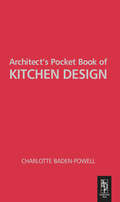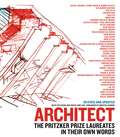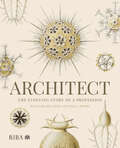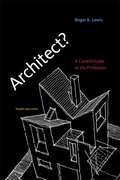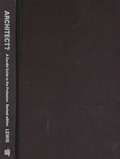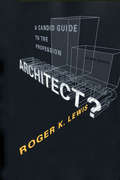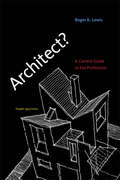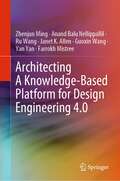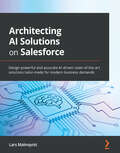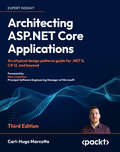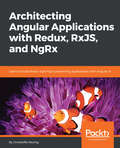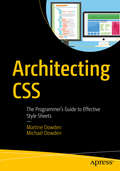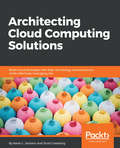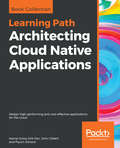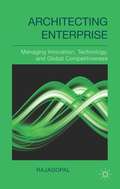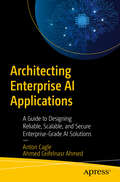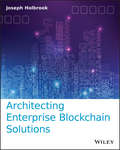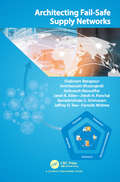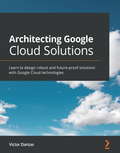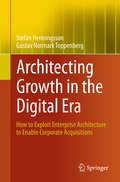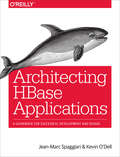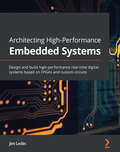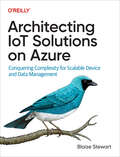- Table View
- List View
Architect's Pocket Book of Kitchen Design (Routledge Pocket Books)
by Charlotte Baden-PowellAs with the best-selling 'Architects Pocket Book' this title includes everyday information which the architect/designer normally has to find from a wide variety of sources and which is not always easily to hand.Focusing on kitchen design, this book is of use to the student as well as the experienced practitioner. It outlines all the information needed to design a workable kitchen, including ergonomics, services such as water and waste, appliances, and material choices for the floor, walls and ceiling. There is no similar compendium currently available.
Architect: The Pritzker Prize Laureates in Their Own Words
by Ruth Peltason Grace Ong YanIn this completely revised and up-to-date edition, the world's most accomplished architects-Gehry, Pei, Meier, Nouvel, Piano, and 37 more-express their views on creativity, inspiration, and legacy in this visually stunning, one-of-a-kind collection.The Pritzker Prize is the most prestigious international prize for architecture. Architect includes all 42 recipients of the Pritzker Prize, and captures in pictures and their own words their awe-inspiring achievements. Organized in reverse chronological order by laureate each chapter features four to six of the architect's major works, including museums, libraries, hotels, places of worship, and more. The text, culled from notebooks, interviews, articles, and speeches illuminates the architects' influences and inspirations, personal philosophy, and aspirations for his own work and the future of architecture. The book includes More than 1000 stunning photographs, blueprints, sketches, and CAD drawings.Architect offers an unprecedented view into the minds of some of the most creative thinkers, dreamers, and builders of the last three decades and reveals that buildings are political, emotional, and spiritual.
Architect: The evolving story of a profession
by Eleanor Jolliffe Paul CrosbyThe architect’s role is constantly adapting. Throughout history it has shifted significantly, shaped by social, cultural, technological and economic forces. The very definition of what an architect is and does has evolved over time from lead builder or master mason to principal designer. A collaborative and reactive profession, it is inextricably linked to the power of the patron, whether the client is an influential and affluent individual or a political, commercial, civic or religious organisation. From Ancient Egypt, where architects were members of the ruling class, tied into the running of the empire, to the 21st century when questions are being raised about the future of the profession, this book, with its engaging narrative, explores the constant threads that remain as the profession adapts. While architects are no longer deified, their ability to imagine a new impending reality in built form implies a visionary dimension to their work. By focusing on both the practicalities of the profession and the more intangible motivations behind design – humans’ need to make a mark upon their surroundings – this volume provides a critical overview of over 3000 years of practice and education. Looking at the key questions of where the architectural profession originated in the Western tradition, why it is, how it is today and where it might be going next, the authors postulate that architects’ ability to adapt and reinvent themselves in the past will stand them in good stead for the uncertainties of the future.
Architect?
by Roger K. LewisSince 1985, "Architect?" has been an essential text for aspiring architects, offering the best basic guide to the profession available. This third edition has been substantially revised and rewritten, with new material covering the latest developments in architectural and construction technologies, digital methodologies, new areas of focus in teaching and practice, evolving aesthetic philosophies, sustainability and green architecture, and alternatives to traditional practice. "Architect?" tells the inside story of architectural education and practice; it is realistic, unvarnished, and insightful. Chapter 1 asks "Why Be an Architect?" and chapter 2 offers reasons "Why Not to Be an Architect. " After this provocative beginning, Architect? goes on to explain and critique architectural education, covering admission, degree and curriculum types, and workload as well as such post-degree options as internship, teaching, and work in related fields. It offers a detailed discussion of professors and practitioners and the "-isms" and "-ologies" most prevalent in teaching and practicing architecture. It explains how an architect works and gets work, and describes architectural services from initial client contact to construction oversight. The new edition also includes a generous selection of drawings and cartoons from the authors Washington Post column, "Shaping the City," offering teachable moments wittily in graphic form. The author, Roger Lewis, has taught, practiced, and written extensively about architecture for many years. In "Architect?" he explains -- for students, professors, practitioners, and even prospective clients -- how architects think and work and what they care about as they strive to make the built environment more commodious, more beautiful, and more sustainable.
Architect? A Candid Guide to the Profession
by Roger K. LewisThis revised edition includes new information pertinent to current education and practice and addresses issues and concerns of great interest to students choosing among different types of programs, schools, firms, and architectural career paths.
Architect? A Candid Guide to the Profession, revised and expanded edition: A Candid Guide To The Profession (The\mit Press Ser.)
by Roger K. LewisThis revised edition of the best basic guide to the architectural profession includes new information pertinent to current education and practice and addresses issues and concerns of great interest to students choosing among different types of programs, schools, firms, and architectural career paths.The first edition of Architect?, published in 1985, quickly became known as the best basic guide to the architectural profession. More than a decade later, it is a standard text for introductory courses on architecture and recommended reading on the application forms of many schools of architecture. This revised edition includes new information pertinent to current education and practice and addresses issues and concerns of great interest to students choosing among different types of programs, schools, firms, and architectural career paths.Roger K. Lewis, a practicing architect and educator, takes a hard look at the education of the architect as he covers such topics as curriculum content, pedagogical theories and methods, program and faculty types, the admission process, internship, compensation, computer-aided design, and the culture of small and large firms. He tells how an architect works and gets work, and explains all aspects of architectural services, from initial client contact to construction oversight.The author describes the benefits of becoming an architect, including the opportunity to express oneself creatively, to improve the environment, and to achieve notoriety. But he doesn't hesitate to show the other side—the lack of steady work and appropriate compensation, the intensity of competition, the restrictions imposed by clients, and the high degree of anxiety and disillusionment among young architects. Written in a clear, accessible style, the book is accompanied by the authors often-humorous illustrations and a valuable appendix.
Architect?, third edition: A Candid Guide to the Profession (The\mit Press Ser.)
by Roger K. LewisThe new edition of an essential text offers an informative, engaging view of the architectural profession from education through practice.Since 1985, Architect? has been an essential text for aspiring architects, offering the best basic guide to the profession available. This third edition has been substantially revised and rewritten, with new material covering the latest developments in architectural and construction technologies, digital methodologies, new areas of focus in teaching and practice, evolving aesthetic philosophies, sustainability and green architecture, and alternatives to traditional practice. Architect? tells the inside story of architectural education and practice; it is realistic, unvarnished, and insightful. Chapter 1 asks “Why Be an Architect?” and chapter 2 offers reasons “Why Not to Be an Architect.” After this provocative beginning, Architect? goes on to explain and critique architectural education, covering admission, degree and curriculum types, and workload as well as such post-degree options as internship, teaching, and work in related fields. It offers a detailed discussion of professors and practitioners and the “-isms” and “-ologies” most prevalent in teaching and practicing architecture. It explains how an architect works and gets work, and describes architectural services from initial client contact to construction oversight. The new edition also includes a generous selection of drawings and cartoons from the author's Washington Post column, “Shaping the City,” offering teachable moments wittily in graphic form.The author, Roger Lewis, has taught, practiced, and written extensively about architecture for many years. In Architect? he explains—for students, professors, practitioners, and even prospective clients—how architects think and work and what they care about as they strive to make the built environment more commodious, more beautiful, and more sustainable.
Architecting A Knowledge-Based Platform for Design Engineering 4.0
by Janet K. Allen Farrokh Mistree Anand Balu Nellippallil Yan Yan Zhenjun Ming Ru Wang Guoxin Wang"Design Engineering for Industry 4.0 (DE4.0) represents the 'human-cyber-physical view of the systems realization ecosystem “that is necessary to accommodate the drivers of Industry 4.0 (IoX) and provide an open ecosystem for the realization of complex systems. Seamless integration of digital threads and digital twins throughout the product design, the development and fulfillment lifecycle; the ability to accommodate diverse and rapidly changing technologies; and the mechanisms to facilitate the creation of new opportunities for the design of products, processes, services, and systems are some of the desired characteristics of DE4.0."Jiao, R., Commuri, S. Panchal, J., Milisavljevic-Syed, J, Allen, J.K., Mistree, F. and Schaefer, D., "Design Engineering in the Age of Industry 4.0," ASME Journal of Mechanical Design, 143(7), 070801, 25 pages.In keeping with the Design Engineering 4.0 construct the authors describe architecting a computer platform to support human designers make decisions associated with the realization of complex engineered systems. The platform is designed to facilitate end-to-end digital integration, customization and personalization, agile collaboration networks, open innovation, co-creation and crowdsourcing, product servitization and anything-as-a-service.Recognizing that simulation models are abstractions of reality the authors opt for a satisficing strategy instead of an optimization strategy. They include fundamentals and then describe tools for architecting a knowledge-based platforms for decision support. Challenges associated with developing a computational platform for decision support for the realization of complex engineered systems in the context of Design Engineering 4.0 are identified. Constructs for formulating design decisions (e.g., selection, compromise, and coupled decisions), knowledge modelling schemes (e.g., ontologies and modular templates), diagrams for designing decision workflows (e.g., the PEI-X diagram), and some analytical methods for robust design under uncertainty are presented. The authors describe integrating the knowledge-based platform to architect a cloud-based platform for decision support promoting co-design and cloud-based design communication essential for mass collaboration and open innovation for Design Engineering 4.0.This book is a valuable resource for researchers, design engineers, and others working on pushing the boundary of digitized manufacturing to include Design Engineering 4.0 principles in designing products, processes, and services.
Architecting AI Solutions on Salesforce: Design powerful and accurate AI-driven state-of-the-art solutions tailor-made for modern business demands
by Lars MalmqvistUse Salesforce's out-of-the-box and advanced integration-based AI capabilities to architect modern enterprise solutions on sales, service, marketing, and commerce clouds to drive digital innovation for your clientsKey FeaturesGet up to speed with Salesforce's AI features and capabilities to meet ever-evolving client needsGet expert advice on key architectural decisions and trade-offs when designing AI-driven Salesforce solutionsIntegrate third-party AI services into applications that modernize your solutionsBook DescriptionThe ever-increasing need for designing state-of-the-art solutions using AI features requires a sound understanding of a vast array of AI capabilities that help you to architect modern solutions. Salesforce Einstein is a set of services that allows seamless implementation of advanced artificial intelligence (AI) features while retaining the ability to cater to custom requirements for the business.This book will help you understand the business and technical benefits of building AI solutions and components available in Salesforce. As you work through a case study of a fictional company beginning to adopt AI in its Salesforce ecosystem, you'll learn how to configure and extend the out-of-the-box features on various Salesforce clouds, their pros, cons, and limitations. You'll also discover how to extend these features using on- and off-platform choices and how to make the best architectural choices when designing custom solutions. Later, you'll advance to integrating third-party AI services such as the Google Translation API, Microsoft Cognitive Services, and Amazon SageMaker on top of your existing solutions. This Salesforce book concludes by taking you through key architectural decisions and trade-offs that may impact the design choices you make.By the end of this book, you'll be able to architect Salesforce AI solutions to meet various customer requirements confidently.What you will learnExplore the AI components available in Salesforce and the architectural model for Salesforce EinsteinExtend the out-of-the-box features using Einstein Services on major Salesforce cloudsUse Einstein declarative features to create your custom solutions with the right approachArchitect AI solutions on marketing, commerce, and industry cloudsUse Salesforce Einstein Platform Services APIs to create custom AI solutionsIntegrate third-party AI services such as Microsoft Cognitive Services and Amazon SageMaker into SalesforceWho this book is forThis book is for existing and aspiring technical and functional architects, technical decision-makers working on the Salesforce ecosystem, and those responsible for designing AI solutions in their Salesforce ecosystem. Lead and senior Salesforce developers who want to start their Salesforce architecture journey will also find this book helpful. Working knowledge of the Salesforce platform is necessary to get the most out of this book.
Architecting ASP.NET Core Applications: An atypical design patterns guide for .NET 8, C# 12, and beyond
by Carl-Hugo MarcotteBackend design like you've never seen it before – a guide to building SOLID ASP.NET Core web apps that stand the test of time. Featuring more Minimal APIs, more testing, a new e-commerce project, and the modular monolith! Purchase of the print or Kindle book includes a free PDF eBook.Key FeaturesLearn multiple ways to organize your application code and become a more flexible ASP.NET Core developerExplore hands-on design patterns, learn architectural principles, and how to sidestep anti-patternsRefactor code toward modern application design, such as feature-based vertical slice and clean architectureBook DescriptionThis unique ASP.NET Core book will fill in the gaps in your REST API and backend designs. Learn how to build robust, maintainable, and flexible apps using Gang of Four (GoF) design patterns and modern architectural principles. This new edition is updated for .NET 8 and focuses exclusively on the backend, with new content on REST APIs, the REPR pattern, and building modular monoliths. You’ll start by covering foundational concepts like REST, the SOLID principles, Minimal APIs, dependency injection in .NET, and other ASP.NET Core 8 mechanisms. Then, you’ll learn to develop components using design patterns, including many from the GoF. Finally, you’ll explore organizing your application code with patterns that vary from layers to feature-oriented vertical slice designs, covering CQS and a deep dive into microservices along the way. A brand-new e-commerce project at the end of the book will tie it all together. This how-to guide will teach you how to assemble your own APIs from building blocks, to suit whatever real-world requirements you may have.What you will learnApply the SOLID principles for building flexible and maintainable softwareTest your apps effectively with automated tests, including black-box testingEmbark on mastering ASP.NET Core dependency injectionWork with GoF design patterns including strategy, decorator, facade, and compositeDesign REST APIs using Minimal APIs and ASP.NET Core MVCDiscover layering and the tenets of clean architectureUse feature-oriented techniques as an alternative to layeringExplore microservices, CQS, REPR, vertical slice architecture, and many more patternsWho this book is forThis book is for intermediate-level ASP.NET Core developers who want to improve their C# app code structure and API design skills. ASP.NET developers who want to modernize their knowledge and enhance their technical architecture skills will also like this book. It’s also a good refresher for those in software design roles with more experience looking to update their expertise. A good knowledge of C# programming and a basic understanding of web concepts is necessary to get the most out of this book, though some refreshers are included along the way.
Architecting Angular Applications with Redux, RxJS, and NgRx: Learn to build Redux style high-performing applications with Angular 6
by Christoffer NoringManage state in Angular to write high performing web apps by combining the power of Flux, RxJS, and NgRxKey Features- Learn what makes an excellent Angular application architecture- Use Redux to write performant, consistent Angular applications- Incorporate Reactive Programming principles and RxJS to make it easier to develop, test, and debug your Angular applicationsBook DescriptionManaging the state of large-scale web applications is a highly challenging task with the need to align different components, backends, and web workers harmoniously. When it comes to Angular, you can use NgRx, which combines the simplicity of Redux with the reactive programming power of RxJS to build your application architecture, making your code elegant and easy to reason about, debug, and test.In this book, we start by looking at the different ways of architecting Angular applications and some of the patterns that are involved in it. This will be followed by a discussion on one-way data flow, the Flux pattern, and the origin of Redux.The book introduces you to declarative programming or, more precisely, functional programming and talks about its advantages. We then move on to the reactive programming paradigm. Reactive programming is a concept heavily used in Angular and is at the core of NgRx. Later, we look at RxJS, as a library and master it. We thoroughly describe how Redux works and how to implement it from scratch. The two last chapters of the book cover everything NgRx has to offer in terms of core functionality and supporting libraries, including how to build a micro implementation of NgRx.This book will empower you to not only use Redux and NgRx to the fullest, but also feel confident in building your own version, should you need it.What you will learnUnderstand the one-way data flow and Flux patternWork with functional programming and asynchronous data streamsFigure out how RxJS can help us address the flaws in promisesSet up different versions of cascading callsExplore advanced operatorsGet familiar with the Redux pattern and its principlesTest and debug different features of your applicationBuild your own lightweight app using Flux, Redux, and NgRxWho this book is forIf you have been developing Angular applications and want to dive deeper into the Angular architecture with Redux, RxJS, and NgRx to write robust web apps, then this book is for you.
Architecting CSS: The Programmer’s Guide to Effective Style Sheets
by Martine Dowden Michael DowdenLeverage various CSS features in combination with popular architectures in order to bring your style sheets back under your control. While CSS is the primary technology used for building beautiful web user interfaces, the style sheet files themselves are often quite ugly; left chaotic and unstructured through lack of a consistent architectural approach. By addressing the structure of your style sheets in the same way that you do with code, see how it is possible to create style rules that are clean and easy to read. Dig deep into CSS fundamentals and learn how to use the available selectors to build powerful rules.You will learn how to use cascading, inheritance, pseudo-classes, pre-processors, and components to produce cleaner, DRY-er style sheets, and how to let these features work for you instead of leading you down the road of rule duplication and design inconsistencies. Embrace the clean, semantic HTML to make your code easier to read, while supporting accessibility and assistive technologies.Separate the concerns of layout and style to simplify dynamic theming and white labeling, making you a marketing hero. Once you've finished this book you will have an advanced knowledge of CSS structures and architectural patterns that will take the pain out of style sheets for you (and your coworkers), and help you implement designs faster and easier than ever before. What You'll LearnUnderstand the core CSS fundamentals of Inheritance, Cascading, and SpecificityWork with architecture and design patterns for better organization and maintenanceMaximize code reuse with CSS precompilersReview the strengths and weaknesses of popular architecture patterns Who This Book Is For Primarily for front-end web developers and UI designers and anyone who works with CSS, particularly if they find it cumbersome and inelegant. It’s also suitable for software architects and tech leads who are responsible for the maintainability of their code base.
Architecting Cloud Computing Solutions: Build cloud strategies that align technology and economics while effectively managing risk
by Kevin L. Jackson Scott GoesslingAccelerating Business and Mission Success with Cloud Computing.Key FeaturesA step-by-step guide that will practically guide you through implementing Cloud computing services effectively and efficiently. Learn to choose the most ideal Cloud service model, and adopt appropriate Cloud design considerations for your organization.Leverage Cloud computing methodologies to successfully develop a cost-effective Cloud environment successfully. Book DescriptionCloud adoption is a core component of digital transformation. Scaling the IT environment, making it resilient, and reducing costs are what organizations want. Architecting Cloud Computing Solutions presents and explains critical Cloud solution design considerations and technology decisions required to choose and deploy the right Cloud service and deployment models, based on your business and technology service requirements.This book starts with the fundamentals of cloud computing and its architectural concepts. It then walks you through Cloud service models (IaaS, PaaS, and SaaS), deployment models (public, private, community, and hybrid) and implementation options (Enterprise, MSP, and CSP) to explain and describe the key considerations and challenges organizations face during cloud migration. Later, this book delves into how to leverage DevOps, Cloud-Native, and Serverless architectures in your Cloud environment and presents industry best practices for scaling your Cloud environment. Finally, this book addresses (in depth) managing essential cloud technology service components such as data storage, security controls, and disaster recovery. By the end of this book, you will have mastered all the design considerations and operational trades required to adopt Cloud services, no matter which cloud service provider you choose. What you will learn Manage changes in the digital transformation and cloud transition process Design and build architectures that support specific business cases Design, modify, and aggregate baseline cloud architectures Familiarize yourself with cloud application security and cloud computing security threats Design and architect small, medium, and large cloud computing solutionsWho this book is forIf you are an IT Administrator, Cloud Architect, or a Solution Architect keen to benefit from cloud adoption for your organization, then this book is for you.Small business owners, managers, or consultants will also find this book useful. No prior knowledge of Cloud computing is needed.
Architecting Cloud Native Applications: Design high-performing and cost-effective applications for the cloud
by John Gilbert Kamal Arora Erik Farr Piyum ZonoozApply cloud native patterns and practices to deliver responsive, resilient, elastic, and message-driven systems with confidence Key Features Discover best practices for applying cloud native patterns to your cloud applications Explore ways to effectively plan resources and technology stacks for high security and fault tolerance Gain insight into core architectural principles using real-world examples Book Description Cloud computing has proven to be the most revolutionary IT development since virtualization. Cloud native architectures give you the benefit of more flexibility over legacy systems. This Learning Path teaches you everything you need to know for designing industry-grade cloud applications and efficiently migrating your business to the cloud. It begins by exploring the basic patterns that turn your database inside out to achieve massive scalability. You'll learn how to develop cloud native architectures using microservices and serverless computing as your design principles. Then, you'll explore ways to continuously deliver production code by implementing continuous observability in production. In the concluding chapters, you'll learn about various public cloud architectures ranging from AWS and Azure to the Google Cloud Platform, and understand the future trends and expectations of cloud providers. By the end of this Learning Path, you'll have learned the techniques to adopt cloud native architectures that meet your business requirements. This Learning Path includes content from the following Packt products: Cloud Native Development Patterns and Best Practices by John Gilbert Cloud Native Architectures by Erik Farr et al. What you will learn Understand the difference between cloud native and traditional architecture Automate security controls and configuration management Minimize risk by evolving your monolithic systems into cloud native applications Explore the aspects of migration, when and why to use it Apply modern delivery and testing methods to continuously deliver production code Enable massive scaling by turning your database inside out Who this book is for This Learning Path is designed for developers who want to progress into building cloud native systems and are keen to learn the patterns involved. Software architects, who are keen on designing scalable and highly available cloud native applications, will also find this Learning Path very useful. To easily grasp these concepts, you will need basic knowledge of programming and cloud computing.
Architecting Data and Machine Learning Platforms: Enable Analytics and AI-Driven Innovation in the Cloud
by Valliappa Lakshmanan Marco Tranquillin Firat TekinerAll cloud architects need to know how to build data platforms that enable businesses to make data-driven decisions and deliver enterprise-wide intelligence in a fast and efficient way. This handbook shows you how to design, build, and modernize cloud native data and machine learning platforms using AWS, Azure, Google Cloud, and multicloud tools like Snowflake and Databricks.Authors Marco Tranquillin, Valliappa Lakshmanan, and Firat Tekiner cover the entire data lifecycle from ingestion to activation in a cloud environment using real-world enterprise architectures. You'll learn how to transform, secure, and modernize familiar solutions like data warehouses and data lakes, and you'll be able to leverage recent AI/ML patterns to get accurate and quicker insights to drive competitive advantage.You'll learn how to:Design a modern and secure cloud native or hybrid data analytics and machine learning platformAccelerate data-led innovation by consolidating enterprise data in a governed, scalable, and resilient data platformDemocratize access to enterprise data and govern how business teams extract insights and build AI/ML capabilitiesEnable your business to make decisions in real time using streaming pipelinesBuild an MLOps platform to move to a predictive and prescriptive analytics approach
Architecting Data-Intensive Applications: Develop scalable, data-intensive, and robust applications the smart way
by Anuj KumarArchitect and design data-intensive applications and, in the process, learn how to collect, process, store, govern, and expose data for a variety of use casesKey FeaturesIntegrate the data-intensive approach into your application architectureCreate a robust application layout with effective messaging and data querying architectureEnable smooth data flow and make the data of your application intensive and fastBook DescriptionAre you an architect or a developer who looks at your own applications gingerly while browsing through Facebook and applauding it silently for its data-intensive, yet fluent and efficient, behaviour? This book is your gateway to build smart data-intensive systems by incorporating the core data-intensive architectural principles, patterns, and techniques directly into your application architecture.This book starts by taking you through the primary design challenges involved with architecting data-intensive applications. You will learn how to implement data curation and data dissemination, depending on the volume of your data. You will then implement your application architecture one step at a time. You will get to grips with implementing the correct message delivery protocols and creating a data layer that doesn’t fail when running high traffic. This book will show you how you can divide your application into layers, each of which adheres to the single responsibility principle. By the end of this book, you will learn to streamline your thoughts and make the right choice in terms of technologies and architectural principles based on the problem at hand.What you will learnUnderstand how to envision a data-intensive systemIdentify and compare the non-functional requirements of a data collection componentUnderstand patterns involving data processing, as well as technologies that help to speed up the development of data processing systemsUnderstand how to implement Data Governance policies at design time using various Open Source ToolsRecognize the anti-patterns to avoid while designing a data store for applicationsUnderstand the different data dissemination technologies available to query the data in an efficient mannerImplement a simple data governance policy that can be extended using Apache FalconWho this book is forThis book is for developers and data architects who have to code, test, deploy, and/or maintain large-scale, high data volume applications. It is also useful for system architects who need to understand various non-functional aspects revolving around Data Intensive Systems.
Architecting Enterprise
by RajagopalThe discussion in this book provides an introduction to the concept of entrepreneurship and entrepreneurial business management. The author covers many elements of the entrepreneurial management discipline including choosing a business, organizing, financing, marketing, developing an offering that the market will value, and growing a business.
Architecting Enterprise AI Applications: A Guide to Designing Reliable, Scalable, and Secure Enterprise-Grade AI Solutions
by Anton Cagle Ahmed Mohamed AhmedThis book explores how to define, design, and maintain enterprise AI applications, exploring the impacts they will have on the teams who work with them. The book is structured into four parts. In Part 1: Defining Your AI Application, you are introduced to the dynamic interplay between human adaptability and AI specialization, the concept of meta systems, and the mechanics of prediction machines. In Part 2: Designing Your AI Application, the book delves into the anatomy of an AI application, unraveling the intricate relationships among data, machine learning, and reasoners. This section introduces the building blocks and enterprise architectural framework for designing multi-agent systems. Part 3: Maintaining Your AI Application takes a closer look at the ongoing life cycle of AI systems. You are guided through the crucial aspects of testing and test automation, providing a solid foundation for effective development practices. This section covers the critical tasks of security and information curation that ensure the long-term success of enterprise AI applications. The concluding section, Part 4: AI Enabled Teams, navigates the evolving landscape of collaborative efforts between humans and AI. It explores the impact of AI on remote work dynamics and introduces the new roles of the expert persona and the AI handler. This section concludes with a deep dive into the legal and ethical dimensions that AI-enabled teams must navigate. This book is a comprehensive guide that not only equips developers, architects, and product owners with the technical know-how of AI application development, but also delves into the broader implications for teams and society. What You Will Learn Understand the algorithms and processes that enable AI to make accurate predictions and enhance decision making Grasp the concept of metasystems and their role in the design phase of AI applications Know how data, machine learning, and reasoners drive the functionality and decision-making capabilities of AI applications Know the architectural components necessary for scalable and maintainable multi-agent AI applications Understand methodologies for testing AI applications, ensuring their robustness, accuracy, and reliability in real-world applications Understand the evolving dynamics of human-AI coordination facing teams in the new enterprise working environment Who This book Is For A diverse audience, primarily targeting enterprise architects, middle managers, tech leads, and team leads entrenched in the IT sector or possessing a tech-savvy background, including professionals such as digital marketers. Additionally, tech-savvy individual contributors—ranging from digital content creators and data analysts to administrators and programmers—stand to benefit significantly.
Architecting Enterprise Blockchain Solutions
by Joseph HolbrookDemystify architecting complex blockchain applications in enterprise environments Architecting Enterprise Blockchain Solutions helps engineers and IT administrators understand how to architect complex blockchain applications in enterprise environments. The book takes a deep dive into the intricacies of supporting and securing blockchain technology, creating and implementing decentralized applications, and incorporating blockchain into an existing enterprise IT infrastructure. Blockchain is a technology that is experiencing massive growth in many facets of business and the enterprise. Most books around blockchain primarily deal with how blockchains are related to cryptocurrency or focus on pure blockchain development. This book teaches what blockchain technology is and offers insights into its current and future uses in high performance networks and complex ecosystems. • Provides a practical, hands-on approach • Demonstrates the power and flexibility of enterprise blockchains such as Hyperledger and R3 Corda • Explores how blockchain can be used to solve complex IT support and infrastructure problems • Offers numerous hands-on examples and diagrams Get ready to learn how to harness the power and flexibility of enterprise blockchains!
Architecting Fail‐Safe Supply Networks
by Jitesh H. Panchal Shabnam Rezapour Amirhossein Khosrojerdi Golnoosh Rasoulifar Janet K. Allen Ramakrishnan S. Srinivasan Jeffrey D. Tew Farrokh MistreeA fail-safe supply network is designed to mitigate the impact of variations and disruptions on people and corporations. This is achieved by (1) developing a network structure to mitigate the impact of disruptions that distort the network structure and (2) planning flow through the network to neutralize the effects of variations. In this monograph, we propose a framework, develop mathematical models and provide examples of fail-safe supply network design. We show that, contrary to current thinking as embodied in the supply network literature, disruption management decisions made at the strategic network design level are not independent from variation management decisions made at the operational level. Accordingly, we suggest that it is beneficial to manage disruptions and variations concurrently in supply networks. This is achieved by architecting fail-safe supply networks, which are characterized by the following elements: reliability, robustness, flexibility, structural controllability, and resilience. Organizations can use the framework presented in this monograph to manage variations and disruptions. Managers can select the best operational management strategies for their supply networks considering variations in supply and demand, and identify the best network restoration strategies including facility fortification, backup inventory, flexible production capacity, flexible inventory, and transportation route reconfiguration. The framework is generalizable to other complex engineered networks.
Architecting Google Cloud Solutions: Learn to design robust and future-proof solutions with Google Cloud technologies
by Victor DantasAchieve your infrastructure goals and optimize business processes by designing robust, highly available, and dynamic solutionsKey FeaturesGain hands-on experience in designing and managing high-performance cloud solutionsLeverage Google Cloud Platform to optimize technical and business processes using cutting-edge technologies and servicesUse Google Cloud Big Data, AI, and ML services to design scalable and intelligent data solutionsBook DescriptionGoogle has been one of the top players in the public cloud domain thanks to its agility and performance capabilities. This book will help you design, develop, and manage robust, secure, and dynamic solutions to successfully meet your business needs. You'll learn how to plan and design network, compute, storage, and big data systems that incorporate security and compliance from the ground up. The chapters will cover simple to complex use cases for devising solutions to business problems, before focusing on how to leverage Google Cloud's Platform-as-a-Service (PaaS) and Software-as-a-Service (SaaS) capabilities for designing modern no-operations platforms. Throughout this book, you'll discover how to design for scalability, resiliency, and high availability. Later, you'll find out how to use Google Cloud to design modern applications using microservices architecture, automation, and Infrastructure-as-Code (IaC) practices. The concluding chapters then demonstrate how to apply machine learning and artificial intelligence (AI) to derive insights from your data. Finally, you will discover best practices for operating and monitoring your cloud solutions, as well as performing troubleshooting and quality assurance. By the end of this Google Cloud book, you'll be able to design robust enterprise-grade solutions using Google Cloud Platform.What you will learnGet to grips with compute, storage, networking, data analytics, and pricingDiscover delivery models such as IaaS, PaaS, and SaaSExplore the underlying technologies and economics of cloud computingDesign for scalability, business continuity, observability, and resiliencySecure Google Cloud solutions and ensure complianceUnderstand operational best practices and learn how to architect a monitoring solutionGain insights into modern application design with Google CloudLeverage big data, machine learning, and AI with Google CloudWho this book is forThis book is for cloud architects who are responsible for designing and managing cloud solutions with GCP. You'll also find the book useful if you're a system engineer or enterprise architect looking to learn how to design solutions with Google Cloud. Moreover, cloud architects who already have experience with other cloud providers and are now beginning to work with Google Cloud will benefit from the book. Although an intermediate-level understanding of cloud computing and distributed apps is required, prior experience of working in the public and hybrid cloud domain is not mandatory.
Architecting Growth in the Digital Era: How to Exploit Enterprise Architecture to Enable Corporate Acquisitions
by Stefan Henningsson Gustav Normark ToppenbergThis book provides the reader with the cognitive keys and practical guidelines to manage acquisitive growth in the digital era. It takes a distinct managerial perspective on acquisitions, with a relentless focus on how Enterprise Architecture (EA) relates to value creation. The book builds upon an extensive fundament of rigorous research, first-hand experiences from using Enterprise Architecture to catalyze acquisitions in several Fortune 500 companies, and a wide pool of case examples from leading firms in the US, Europe and Australia.The book is divided into three parts. Part I addresses the fundament for the book by decomposing the problem of acquisitive growth and explaining how advance in EA practices have created the potential for mitigating the challenges. Part II then details how an advanced EA capability can contribute to the different phases of an acquisition process. Lastly, Part III provides hands-on guidance on how to implement EA in the acquisition process and concludes with a summary and personal advice from the authors as notes on the journey ahead.Overall, this book explains how Enterprise Architecture can be used to unlock the value potential in acquisitions without bringing the need for a major organizational restructure. It provides managers, EA professionals, and MBA students with the cognitive keys to characterize the problems and to craft and implement effective solutions.
Architecting HBase Applications: A Guidebook for Successful Development and Design
by Kevin O'Dell Jean-Marc SpaggiariHBase is a remarkable tool for indexing mass volumes of data, but getting started with this distributed database and its ecosystem can be daunting. With this hands-on guide, you’ll learn how to architect, design, and deploy your own HBase applications by examining real-world solutions. Along with HBase principles and cluster deployment guidelines, this book includes in-depth case studies that demonstrate how large companies solved specific use cases with HBase.Authors Jean-Marc Spaggiari and Kevin O’Dell also provide draft solutions and code examples to help you implement your own versions of those use cases, from master data management (MDM) and document storage to near real-time event processing. You’ll also learn troubleshooting techniques to help you avoid common deployment mistakes.Learn exactly what HBase does, what its ecosystem includes, and how to set up your environmentExplore how real-world HBase instances were deployed and put into productionExamine documented use cases for tracking healthcare claims, digital advertising, data management, and product qualityUnderstand how HBase works with tools and techniques such as Spark, Kafka, MapReduce, and the Java APILearn how to identify the causes and understand the consequences of the most common HBase issues
Architecting High-Performance Embedded Systems: Design and build high-performance real-time digital systems based on FPGAs and custom circuits
by Jim LedinExplore the complete process of developing systems based on field-programmable gate arrays (FPGAs), including the design of electronic circuits and the construction and debugging of prototype embedded devicesKey FeaturesLearn the basics of embedded systems and real-time operating systemsUnderstand how FPGAs implement processing algorithms in hardwareDesign, construct, and debug custom digital systems from scratch using KiCadBook DescriptionModern digital devices used in homes, cars, and wearables contain highly sophisticated computing capabilities composed of embedded systems that generate, receive, and process digital data streams at rates up to multiple gigabits per second. This book will show you how to use Field Programmable Gate Arrays (FPGAs) and high-speed digital circuit design to create your own cutting-edge digital systems. Architecting High-Performance Embedded Systems takes you through the fundamental concepts of embedded systems, including real-time operation and the Internet of Things (IoT), and the architecture and capabilities of the latest generation of FPGAs. Using powerful free tools for FPGA design and electronic circuit design, you'll learn how to design, build, test, and debug high-performance FPGA-based IoT devices. The book will also help you get up to speed with embedded system design, circuit design, hardware construction, firmware development, and debugging to produce a high-performance embedded device – a network-based digital oscilloscope. You'll explore techniques such as designing four-layer printed circuit boards with high-speed differential signal pairs and assembling the board using surface-mount components. By the end of the book, you'll have a solid understanding of the concepts underlying embedded systems and FPGAs and will be able to design and construct your own sophisticated digital devices.What you will learnUnderstand the fundamentals of real-time embedded systems and sensorsDiscover the capabilities of FPGAs and how to use FPGA development toolsLearn the principles of digital circuit design and PCB layout with KiCadConstruct high-speed circuit board prototypes at low costDesign and develop high-performance algorithms for FPGAsDevelop robust, reliable, and efficient firmware in CThoroughly test and debug embedded device hardware and firmwareWho this book is forThis book is for software developers, IoT engineers, and anyone who wants to understand the process of developing high-performance embedded systems. You'll also find this book useful if you want to learn about the fundamentals of FPGA development and all aspects of firmware development in C and C++. Familiarity with the C language, digital circuits, and electronic soldering is necessary to get started.
Architecting IoT Solutions on Azure: Conquering Complexity for Scalable Device and Data Management
by Blaize StewartHow can you make sense of the complex IoT landscape? With dozens of components ranging from devices to metadata about the devices, it's easy to get lost among the possibilities. But it's not impossible if you have the right guide to help you navigate all the complexities. This practical book shows developers, architects, and IT managers how to build IoT solutions on Azure. Author Blaize Stewart presents a comprehensive view of the IoT landscape. You'll learn about devices, device management at scale, and the tools Azure provides for building globally distributed systems. You'll also explore ways to organize data by choosing the appropriate dataflow and data storage technologies. The final chapters examine data consumption and solutions for delivering data to consumers with Azure. Get the architectural guidance you need to create holistic solutions with devices, data, and everything in between. This book helps you: Meet the demands of an IoT solution with Azure-provided functionality Use Azure to create complete scalable and secure IoT systemsUnderstand how to articulate IoT architecture and solutions Guide conversations around common problems that IoT applications solve Select the appropriate technologies in the Azure space to build IoT applications
